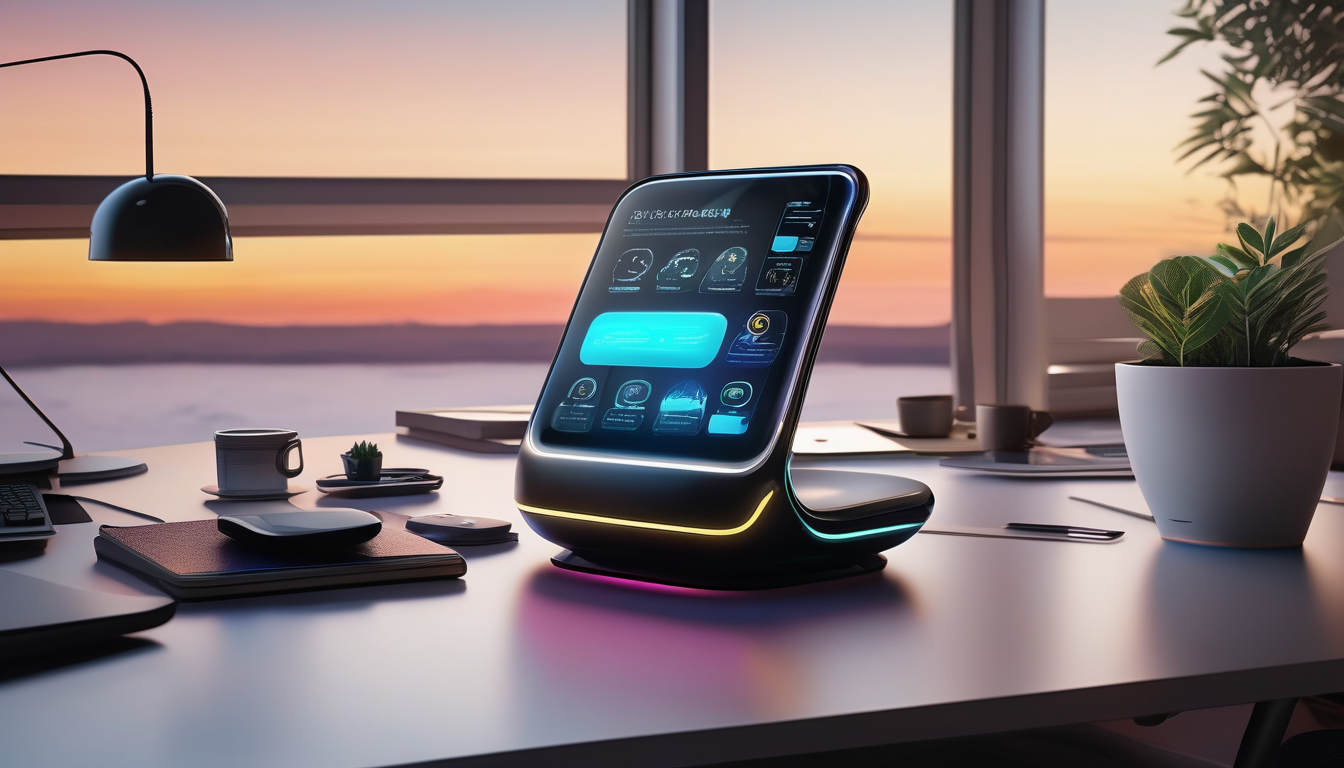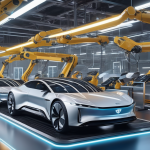How AI-Powered Personal Assistants Are Evolving

The world of technology is changing at lightning speed, and AI-powered personal assistants are at the forefront of this revolution. These digital companions have transformed from basic task managers into complex systems that can understand our language, learn our preferences, and even predict our needs. Imagine having a helper that not only responds to your commands but also anticipates your requests before you even ask. That’s the magic of AI!
As we dive deeper into the evolution of these remarkable tools, it’s fascinating to see how they have adapted to our daily lives. Remember when setting reminders required manual input? Now, with a simple voice command, you can have your assistant schedule appointments, send messages, or even control your smart home devices. This evolution signifies not just technological advancements but also a shift in how we interact with technology.
AI personal assistants are becoming more intuitive, thanks to key technologies like natural language processing (NLP) and machine learning. NLP allows these assistants to understand and interpret human language, making conversations feel more natural. It’s like chatting with a friend who knows exactly what you mean, even if you don’t articulate it perfectly. Furthermore, machine learning enables these assistants to learn from each interaction, tailoring their responses to better suit individual users over time.
But the evolution doesn’t stop there. The impact of AI personal assistants on our daily lives is profound. They not only enhance productivity by automating mundane tasks but also improve accessibility for individuals with disabilities. With voice-activated controls, these assistants can empower users to navigate their environments with greater ease and independence.
As we look to the future, the potential for AI-powered personal assistants seems limitless. They are not just tools; they are becoming integral parts of our lives, seamlessly blending into our routines. With ongoing advancements in technology, who knows what amazing capabilities lie ahead? One thing is for sure—our relationship with these digital companions will only grow stronger.

The Rise of AI Personal Assistants
AI personal assistants have become an essential part of our daily lives, evolving rapidly from mere task managers to advanced systems that can understand and respond to human language. Just think about it: not too long ago, we were using simple apps to set reminders or check the weather. Now, we have intelligent companions that learn our preferences, anticipate our needs, and interact with us in a more human-like manner. This transformation is nothing short of remarkable.
The journey of AI personal assistants began with basic functionalities, but as technology progressed, so did their capabilities. Today, these assistants can perform a myriad of tasks, from managing our calendars to controlling smart home devices. They are like having a personal secretary, a friend, and a tech guru all rolled into one. Imagine waking up in the morning and having your assistant remind you of your schedule, adjust your thermostat, and even suggest breakfast recipes—all with just your voice!
One of the key factors contributing to this rise is the integration of natural language processing (NLP) and machine learning. These technologies allow personal assistants to understand context, recognize speech patterns, and adapt to individual user behaviors. For instance, if you frequently ask for traffic updates before leaving for work, your assistant will start providing this information proactively. This level of personalization is what sets modern AI personal assistants apart.
Moreover, the accessibility of these technologies has played a significant role in their adoption. With the rise of smartphones and smart speakers, AI assistants are now available at our fingertips, making it easier than ever to integrate them into our daily routines. They’ve transitioned from being a novelty to a necessity, enhancing our productivity and simplifying our lives.
As we look to the future, the potential for AI personal assistants seems limitless. They are not just here to assist but to evolve alongside us. The question is, how much more will they learn and adapt? The rise of AI personal assistants marks a new era in technology, where our devices don’t just respond to commands but engage with us in meaningful ways.

Key Technologies Driving Evolution
In the fast-paced world of technology, AI personal assistants have undergone a remarkable transformation, thanks in large part to several key technologies. These advancements have not only enhanced the functionality of these assistants but have also significantly improved user experiences. At the heart of this evolution are three primary technologies: Natural Language Processing (NLP), Machine Learning, and Speech Recognition.
Natural Language Processing (NLP) is a game changer. It enables AI personal assistants to understand and interpret human language in a way that feels natural and intuitive. Imagine having a conversation with a friend who just gets you—NLP makes that possible. With context-aware responses, these assistants can engage in more meaningful interactions, making them feel less like machines and more like companions in our daily lives.
With NLP, AI assistants can analyze the context of your requests, allowing them to respond appropriately. For example, if you ask, “What’s the weather like?” they can provide a forecast tailored to your location without needing you to specify it. This level of understanding is crucial for creating a seamless user experience, making interactions feel fluid and effortless.
Another pivotal technology is speech recognition. This technology allows personal assistants to accurately transcribe spoken language into text. Think of it as having a personal secretary who can jot down your thoughts in real-time. This feature not only facilitates hands-free operation but also enhances accessibility for users who may have difficulties typing. The accuracy of speech recognition has improved dramatically, making it a reliable tool for everyone.
Contextual understanding takes things a step further. It allows AI assistants to grasp the nuances of conversations, enabling them to provide relevant responses and anticipate user needs. For instance, if you frequently ask your assistant about traffic conditions during your morning commute, it will learn to proactively offer updates without you needing to ask. This ability to predict and respond to user behavior is what sets advanced AI assistants apart from their predecessors.
Lastly, machine learning algorithms play a crucial role in this evolution. They empower AI assistants to learn from user interactions, tailoring their suggestions based on individual preferences. Over time, these assistants become more adept at serving your unique needs, making them indispensable tools in our daily lives.
Natural Language Processing (NLP)
Natural Language Processing, or NLP, is a game changer in the realm of AI personal assistants. Imagine having a conversation with your assistant as if you were chatting with a friend—this is the magic of NLP. It allows these systems to understand and interpret human language in a way that feels natural and intuitive. Gone are the days when you had to speak in robotic commands; now, you can express your thoughts freely, and your assistant will get it.
At its core, NLP combines linguistics and computer science to enable machines to process human language. This technology is crucial for creating a seamless user experience. When you ask your assistant, “What’s the weather like today?” it doesn’t just pull data; it understands your query’s context and responds with relevant information. This ability to interpret meaning is what sets modern assistants apart.
The evolution of NLP is driven by several key components:
- Tokenization: Breaking down sentences into words or phrases for easier analysis.
- Sentiment Analysis: Understanding the emotions behind the words, which helps in providing more empathetic responses.
- Named Entity Recognition: Identifying specific entities like names, dates, and locations to enhance the assistant’s contextual understanding.
By leveraging these components, AI personal assistants can engage in more meaningful conversations with users. For instance, if you ask your assistant to remind you about a meeting next week, it not only records the information but also understands the urgency and can provide timely reminders as the date approaches.
The future of NLP is incredibly promising. As these systems continue to learn from interactions, they will become even more adept at understanding complex language structures and nuances. This evolution will not only enhance user experience but also open doors to new applications, making your AI assistant an even more indispensable part of your daily routine.
Speech Recognition
Speech recognition technology has revolutionized the way we interact with our devices, transforming our spoken words into actionable commands. Imagine being able to control your smartphone or smart home devices just by talking to them—this is the magic of speech recognition! It’s like having a personal assistant who understands you perfectly, no matter how busy your hands are.
This technology works by converting spoken language into text, allowing users to engage with their devices in a more natural and intuitive way. For instance, when you say, “Hey Siri, set a timer for 10 minutes,” the assistant instantly grasps your request and acts accordingly. This seamless interaction not only enhances user experience but also promotes accessibility for those who may struggle with traditional input methods.
Moreover, the accuracy of speech recognition has significantly improved over the years, thanks to advancements in machine learning and artificial intelligence. The systems are now capable of understanding various accents, dialects, and even different languages. This ability to adapt to individual users makes speech recognition a powerful tool in our daily lives.
Some of the key benefits of speech recognition technology include:
- Hands-Free Operation: Perfect for multitasking, allowing users to perform tasks without needing to touch their devices.
- Increased Efficiency: Commands can be executed faster than typing, saving precious time.
- Enhanced Accessibility: Provides opportunities for individuals with disabilities to interact with technology more easily.
As we look to the future, the potential for speech recognition is boundless. Imagine a world where your personal assistant not only understands your commands but also anticipates your needs based on your previous interactions. This level of contextual awareness could redefine our relationship with technology, making it more personal and efficient than ever before.
In conclusion, speech recognition is not just a technological advancement; it’s a glimpse into a future where communication with our devices becomes as natural as talking to a friend. With continued innovations, we can expect even more exciting developments in the realm of AI personal assistants, making our lives easier and more connected.
Contextual Understanding
When we think about conversations, they’re rarely just a string of words; they’re filled with nuance, emotion, and context. This is where AI personal assistants truly shine, thanks to their ability to grasp the subtleties of human communication. Imagine chatting with a friend who not only listens but also understands the underlying feelings and intentions behind your words. That’s the magic of contextual understanding in AI.
Contextual understanding empowers AI personal assistants to move beyond mere command execution. Instead of just responding to direct requests, they can interpret the context of a conversation and provide responses that feel more like a natural dialogue. For instance, if you ask, “What’s the weather like today?” and follow it up with, “And what about tomorrow?”, a traditional assistant might just give you a weather update for today again. However, an advanced AI can recognize that you’re shifting focus and will provide you with the forecast for the next day instead.
This capability is not just a party trick; it fundamentally enhances user experience. Here’s how:
- Improved Relevance: By understanding the context, AI assistants can filter out irrelevant information and deliver responses that align closely with user needs.
- Anticipatory Actions: Contextual awareness allows AI to predict what users might need next. For example, if you’re scheduling a meeting, the assistant might suggest available times based on your calendar and past preferences.
- Personalized Interactions: The more an assistant understands about your preferences and habits, the more tailored its responses can be. This creates a more engaging and satisfying interaction.
As these systems continue to evolve, the potential for greater contextual understanding will only increase. Imagine a personal assistant that not only knows your schedule but also understands your mood and can adjust its tone and responses accordingly. The future is bright for AI personal assistants, and contextual understanding is a key ingredient in making these interactions feel more human.
Machine Learning Algorithms
Machine learning algorithms are the backbone of AI-powered personal assistants, allowing them to evolve from simple tools into intelligent companions that understand and adapt to user behaviors. Imagine having a personal assistant that learns your preferences over time, much like a friend who knows your favorite coffee order or the best time to remind you about a meeting. This is the magic of machine learning!
At the core of these algorithms is the ability to analyze vast amounts of data and identify patterns. When you interact with your AI assistant, it collects data on your commands, questions, and preferences. This data is then processed to enhance the assistant’s personalization. For instance, if you frequently ask for traffic updates at a certain time, the assistant will start to proactively provide this information without you needing to ask.
To illustrate how machine learning works in AI assistants, consider the following key components:
- Data Collection: Every interaction is logged and analyzed to understand user behavior.
- Pattern Recognition: The algorithms identify trends and patterns in the collected data.
- Feedback Loop: The assistant uses feedback from users to refine its responses and suggestions.
This process not only makes the assistant more efficient but also enhances user satisfaction. As the algorithms learn, they can provide more relevant suggestions, whether it’s recommending a new restaurant based on past dining choices or suggesting reminders tailored to your lifestyle.
Moreover, machine learning algorithms contribute to the continuous improvement of AI assistants. They are designed to adapt to changes in user behavior, ensuring that the assistance provided remains relevant and useful. This adaptability is crucial, especially in our fast-paced world where preferences can shift overnight.
In conclusion, machine learning algorithms are essential for the evolution of AI-powered personal assistants. They transform these tools from basic task managers into sophisticated companions that enhance our productivity and make our lives easier. As technology continues to advance, we can only imagine the exciting possibilities that lie ahead!

Impact on Daily Life
AI-powered personal assistants have truly transformed the way we navigate our daily lives. Imagine waking up to a world where your tasks are organized, your reminders are set, and your information is just a voice command away. These intelligent systems have become our personal concierges, handling everything from scheduling meetings to finding the best routes for our daily commutes. With just a simple “Hey, Assistant,” we can access a wealth of information and support, making life not just easier but also more enjoyable.
One of the most significant impacts of these assistants is their ability to enhance productivity. By automating repetitive tasks, they free up our time for more meaningful activities. For instance, consider how much time we spend on mundane tasks:
| Task | Time Spent (Weekly) | Time Saved with AI Assistants |
|---|---|---|
| Email Management | 5 hours | 3 hours |
| Appointment Scheduling | 2 hours | 1.5 hours |
| Reminders and Follow-ups | 3 hours | 2 hours |
As seen in the table, AI assistants can potentially save us a considerable amount of time each week, allowing us to focus on what truly matters. The ability to set reminders, manage emails, and schedule appointments all through voice commands means we can now spend more time on creative pursuits or simply enjoying life.
Moreover, AI personal assistants have a profound impact on accessibility. For individuals with disabilities, these technologies provide a lifeline, enabling them to interact with the world in ways that were previously challenging. Voice-activated controls and tailored assistance mean that tasks that once required significant effort can now be accomplished with ease. This level of accessibility not only empowers users but also fosters a sense of independence.
In conclusion, the impact of AI-powered personal assistants on daily life is nothing short of revolutionary. They help us stay organized, improve our productivity, and enhance accessibility for everyone. As these technologies continue to evolve, we can only imagine the new heights of convenience and efficiency they will bring to our lives.
Enhancing Productivity
In today’s fast-paced world, time is money, and every second counts. AI-powered personal assistants are revolutionizing the way we approach our daily tasks, allowing us to maximize our productivity like never before. Imagine having a digital assistant that not only remembers your appointments but also learns your preferences over time. This is not just a dream; it’s the reality that many of us are experiencing right now.
These intelligent systems are designed to take the mundane out of your routine. They can automate repetitive tasks, such as scheduling meetings, sending reminders, and even managing emails. For instance, instead of manually checking your calendar, you can simply ask your assistant, “What’s on my schedule today?” and receive a concise summary in seconds. This kind of efficiency allows you to focus on what truly matters—your core responsibilities and creative pursuits.
Moreover, AI personal assistants can help in organizing your workflow by prioritizing tasks based on deadlines and importance. Picture this: you have a big project due soon, and your assistant can analyze your workload, suggest when to tackle specific tasks, and even remind you when it’s time to take breaks. This not only keeps you on track but also enhances your overall well-being by preventing burnout.
Furthermore, the integration of AI assistants in team environments can lead to improved collaboration. They can facilitate communication by scheduling meetings, sharing documents, and keeping everyone updated on project statuses. This collaborative aspect is crucial, especially in remote work settings where team members may be scattered across different locations.
To summarize, the impact of AI-powered personal assistants on productivity is profound. They not only save time but also enhance efficiency, allowing users to achieve more with less effort. As these technologies continue to evolve, we can expect even greater capabilities that will transform our work habits in ways we can only imagine. Embracing this change can lead to a more productive and fulfilling work life.
Improving Accessibility
In a world where technology is advancing at a breakneck pace, AI-powered personal assistants are stepping up to the plate, ensuring that everyone, regardless of their abilities, can benefit from modern conveniences. Imagine a scenario where a visually impaired individual can effortlessly manage their daily tasks just by speaking to their assistant. This is not just a dream; it’s a reality that AI is making possible.
One of the most significant ways these assistants enhance accessibility is through voice-activated controls. Users can perform a wide range of functions without needing to use their hands. Whether it’s sending a message, setting reminders, or even controlling smart home devices, voice commands provide a seamless experience. This hands-free operation is particularly beneficial for those with mobility challenges, allowing them to navigate their environments and manage their lives with ease.
Moreover, AI personal assistants are designed to learn and adapt to individual needs. They can customize their responses and actions based on the user’s preferences, making the interaction more intuitive. For instance, if a user frequently asks for information about public transportation, the assistant can proactively offer updates and suggestions without the user even having to ask. This context-aware capability not only saves time but also empowers users to make informed decisions quickly.
Additionally, the integration of features like text-to-speech and speech-to-text technologies further bridges the gap for users with disabilities. These functionalities allow individuals who may struggle with reading or writing to engage with content and communicate effectively. Imagine someone who has difficulty typing; they can simply dictate their thoughts, and the assistant will transcribe them accurately. This capability transforms the way users interact with technology, making it more inclusive.
As we look to the future, the potential for AI personal assistants to improve accessibility is immense. With ongoing advancements in machine learning and natural language processing, these tools will only become more adept at understanding and meeting the unique needs of all users. The journey towards a more accessible world is just beginning, and AI is at the forefront, paving the way for a more inclusive digital landscape.
Frequently Asked Questions
- What are AI-powered personal assistants?
AI-powered personal assistants are software applications that use artificial intelligence to perform tasks or services for individuals. They can manage schedules, provide reminders, and even answer questions, making daily life simpler and more efficient.
- How do AI personal assistants learn user preferences?
These assistants leverage machine learning algorithms to analyze user interactions over time. By understanding patterns in your behavior, they can tailor their responses and suggestions to better suit your needs.
- What technologies are behind AI personal assistants?
Key technologies include natural language processing (NLP), which helps the assistant understand human language, and speech recognition, which allows for hands-free operation. Together, they create a more intuitive user experience.
- Can AI personal assistants help people with disabilities?
Absolutely! AI personal assistants greatly enhance accessibility by providing voice-activated controls and personalized assistance tailored to individual needs, making technology more inclusive.
- Are AI personal assistants secure?
While many AI assistants have robust security measures in place, it’s crucial for users to be aware of privacy settings and data sharing policies. Always review these settings to ensure your information remains secure.
- How can I improve my experience with an AI assistant?
To get the most out of your AI assistant, regularly interact with it and provide feedback. The more you use it, the better it will understand your preferences and the more personalized your experience will become!













